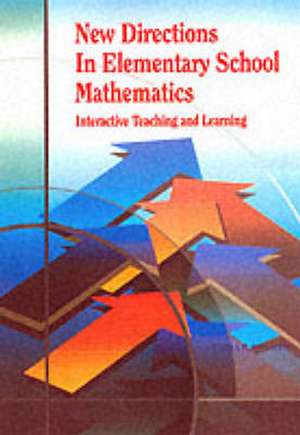New Directions in Elementary School Math
Autor Emma E. Holmesen Limba Engleză Paperback – 28 feb 1995
A new text that focuses on “interactive teaching”, a new, more effective technique for helping elementary-school children learn mathematics! This exciting technique is the lynchpin of a fresh approach to teaching mathematics based on the constructivist theory of learning. It uses modeling, manipulatives, and questioning techniques to encourage learners to reason, problem-solve, communicate, and make connections as they think about numbers and space, construct concepts, and develop procedures for solving mathematical problems.
Preț: 489.17 lei
Nou
Puncte Express: 734
Preț estimativ în valută:
93.62€ • 96.99$ • 78.13£
93.62€ • 96.99$ • 78.13£
Cartea nu se mai tipărește
Doresc să fiu notificat când acest titlu va fi disponibil:
Se trimite...
Preluare comenzi: 021 569.72.76
Specificații
ISBN-13: 9780023564512
ISBN-10: 0023564512
Pagini: 576
Dimensiuni: 215 x 275 x 20 mm
Greutate: 1.66 kg
Ediția:1
Editura: Pearson Education
Colecția Allyn & Bacon
Locul publicării:Boston, United States
ISBN-10: 0023564512
Pagini: 576
Dimensiuni: 215 x 275 x 20 mm
Greutate: 1.66 kg
Ediția:1
Editura: Pearson Education
Colecția Allyn & Bacon
Locul publicării:Boston, United States
Cuprins
1. New Directions in Elementary School Mathematics.
2. Solving Mathematics Problems in the Elementary School.
3. Learning About Number in the Early School Years.
4. Developing Base Ten and Place-Value Knowledge.
5. Learning the Operations for Whole Numbers.
6. Mastering the Basic Facts.
7. Computation with Whole Numbers.
8. Learning About Fractions.
9. Computing with Fractions.
10. Understanding and Computing with Decimals.
11. Exploring Geometry and Developing Spatial Sense.
12. Measurement Learning: Understanding and Skill.
13. Studying Ratio, Proportion, and Percent.
14. Studying Statistics and Probability.
15. Mathematics for Children with Special Needs.
Appendixes.
Index.
Caracteristici
- the text's interactive teaching approach, with its focus on reasoning, problem-solving, and communicating, has been proven effective with children at all levels of mathematics competence.
- these ideas are set forth as exemplars by the Curriculum and Evaluation Standards for School Mathematics of the NCTM.
- the effectiveness of the text's suggestions is supported by strategic references to research throughout the material.
- an introductory problem for solution at the start of every chapter offers an overview of the mathematics and pedagogy to be discussed in the chapter.
- these ideas are set forth as exemplars by the Curriculum and Evaluation Standards for School Mathematics of the NCTM.
- coverage examines the use of models and children's intuitive understanding to help young learners develop mathematics concepts and learn problem-solving procedures.
- included are dozens of practical, class-tested examples of how teachers guide children to construct meaning through mental connections, working alone and in groups, and communicating their ideas effectively.
- included are guidelines for developing experiences appropriate to the mathematics concepts being explored, as well as ideas for how to create assignments and ask “the right type” of questions that lead to higher-order thinking skills.
- included are dozens of practical, class-tested examples of how teachers guide children to construct meaning through mental connections, working alone and in groups, and communicating their ideas effectively.
- discussion of assessment is provided in each chapter.
- Chapter One provides an overview of mathematics assessment.
- other chapters contain a section on assessment techniques related to the specific content presented in that chapter.
- Chapter One provides an overview of mathematics assessment.
- a chapter is devoted to using interactive teaching with children with special needs.
- coverage addresses the needs of minority and culturally-diverse children, as well as ways to eliminate gender bias in mathematics instruction.
- discussions include ideas for teaching children with disabilities, and gifted children, in the regular mathematics classroom.
- coverage addresses the needs of minority and culturally-diverse children, as well as ways to eliminate gender bias in mathematics instruction.
